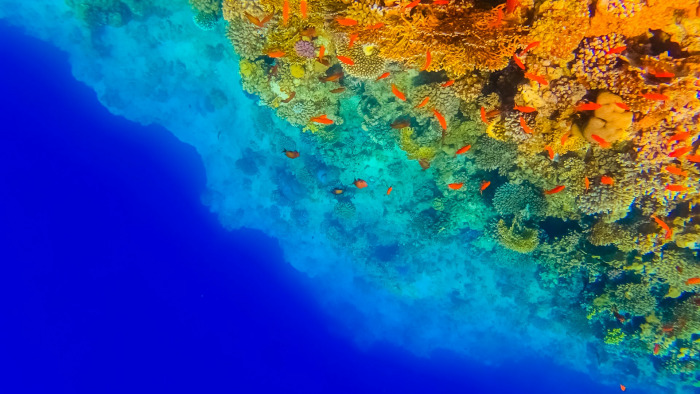
Explora Articles Global warming and the future of work in the wine and fishing industries
December 21, 2022 9 min
Global warming and the future of work in the wine and fishing industries
Climate change is already affecting Spain's wine and fishing industries, two sectors that together employ more than half a million people. And those effects may go further in the future.


Meals with family, friends, and colleagues are frequent on these festive dates in Spain. Two usual foods in those meals are wine and fish or shellfish. Yet, global warming may change this in the future, at least the origin and the way these two products reach our tables. As the planet warms, wine and fishing industries are facing challenges that will likely shape their future, and the work of the people involved in the supply of these food products will also be affected. To understand the dimension of this challenge, let us remember that in 2020 the wine and the fishing industries in Spain generated more than 400,000 and 180,000 direct and indirect jobs, respectively.
We will start with some wine.
Rising temperatures and changing weather patterns are affecting grape-growing regions. Some areas are becoming too hot for some grape varieties, while others are experiencing drought or extreme rainfall. These changes can lead to poor-quality grapes and reduced yields, which can impact the production and availability of some wines.
For instance, the wine industry in La Rioja, the region with the oldest Denomination of Origin in Spain and a reputation for quality and prestige, is at risk because of climate change, with high temperatures, droughts, frost, and heavy rains all affecting the region. Higher temperatures lead to an increase in alcohol content and a decrease in acidity in the grapes, so producers need to advance their harvests. But some heat waves stress vines to the point where they do not have enough water in the soil to photosynthesize properly, causing leaves, berries, and even bunches to dry up. In addition, the region is also suffering new pests previously only seen in the south, such as green mosquitoes and certain varieties of spiders.
In this regard, a study published in 2020 by the University of Alcalá evaluated the impact that a two-degree Celsius increase would have on the principal wine-producing regions of the world and concluded that if nothing changes 56% of the land used to grow grapes will be lost (65% in Spain). Yet, cultivar diversity might half potential losses of winegrowing regions under a 2 °C warming scenario and could reduce losses by a third if warming reaches 4 °C. In this line, scientists say that the adaptive capacity of local types of grapes, such Garnacha and Monastrell, could be the key to cushioning the effects of global warming on wine produced in Spain.
Moving vineyards to higher altitudes is another alternative. Wineries, such Familia Torres in Catalonia, have moved part of their vineyards to the Pyrenees to offset the rise in temperatures and maintain the quality of their wines. And Bodegas Bal Minuta, the winery that grows its grapes at the highest altitude in Spain, does so at 1,300 meters above sea level in the Aragonese Pyrenees.
Of course, Spain is not the only wine-producing country suffering the effects of global warming. We find the same phenomenon in other countries, like Chile, where Patagonia is becoming a promising wine area
But still, the most notable change is how climate warming favors the emergence of a wine industry in countries that traditionally did not produce wine. An example of this is the UK. According to a study by the University of East Anglia, rising temperatures over the coming years could make Britain unseat top wine-producing regions, like Champagne and Burgundy in France, as the best regions to grow Pinot Noir and Chardonnay grapes, two of the staples for Champagne making, will shift northwards away from France. The authors argue that temperatures in the UK wine-growing regions may rise by 1.4°C by 2040, on top of the one-degree rise since the 1980s, meaning the amount of sugar in UK grapes would be more consistent with better wine quality and higher alcohol content. The study also predicts that from now to 2040 the UK wine industry will have vintages as good as 2018 in 60-75% of the seasons, making for a much more consistent end product. Besides, since, compared to major wine-producing countries, the UK has much less land planted with vines, the industry will likely tend towards quality over quantity.
And even further north, we have the case of Sweden. With its vineyards expected to double in size within five years and potentially grow to 10,000 hectares, becoming a new billion-euro industry, Sweden is on its way to becoming a wine destination. Global heating and the cultivation of new grape varieties are among the factors driving Swedish wine production. The main varieties grown in Sweden are Solaris, a white grape, and Rondo, for red wine. Domestic sales of Swedish wine have almost doubled in the past five years, with quantity, quality, and customer interest all increasing. Most Swedish wineries sell their wines in the region, but there are increasing requests from Europe and Asia, particularly Japan.
And what about fish?
The fishing industry is also suffering the effects of climate change. Warmer ocean temperatures are leading to changes in the distribution and behavior of marine species, making it more difficult for fishermen to locate and catch certain types of fish. Additionally, ocean acidification, caused by rising levels of carbon dioxide in the atmosphere, harms shellfish and other species, further reducing the available catch.
According to a report published by the United Nations Food and Agriculture Organization (FAO), climate change will lead to significant changes in the availability and trade of fish products, with potential geopolitical and economic consequences, especially for those countries most dependent on the industry. Model projections suggest by 2050 decreases in maximum catch potential in the world’s exclusive economic zones of between 2.8 percent and 5.3 according to greenhouse gas emission scenario RCP 2.6, and between 7.0 percent and 12.1 percent according to greenhouse gas emission scenario RCP 8.5. The report foresees steeper declines in the tropics, mainly in the South Pacific regions. But still, the catch potential will likely increase (or show a smaller decline) in the high-latitude geographies. (Notice these projections only reflect changes in the capacity of the oceans to produce fish and do not consider the management decisions that governments might take in response).
Among the countries facing high stress levels that will become even higher in the future the report includes Pakistan, Iraq, Morocco, and Spain. In the other extreme, in the list of countries under low stress that will likely remain low in the future we find Myanmar, Cambodia, the Congo, the Central African Republic, and Colombia.
The report also highlights the need for effective adaptation and mitigation measures to address the impacts of climate change on the fisheries and aquaculture sector, including the development of early warning systems, climate-resilient infrastructure, and the promotion of sustainable and adaptive fishing and farming practices.
At this year’s annual scientific conference of the Fisheries Society of the British Isles, Dr. John K Pinnegar, director of the International Marine Climate Change Centre, Cefas, presented an overview of the complex implications of the changing climate for fishermen. According to Pinnegar, climate change is affecting fish and fisheries worldwide. It is causing shifts in the distribution of fish stocks, which can have consequences for quota allocation and fishery access, as well as for the price and availability of fish for consumers. Many fish species have moved poleward in response to warming, with some species shifting 48-403 km over the past 30 years. It is evident in commercial landings data, which show shifts in the distribution of certain species, such as plaice and cod. In addition to changes in distribution, climate change is also affecting fish growth, reproduction, and migratory behavior. And it can have knock-on consequences for safety at sea and catchability.
Meanwhile, in our country, fishermen observe how certain species of fish, such as anchovies and sardines, migrate north, while in the Mediterranean, from time to time, they find in their nets fish they have never seen before. Regarding this phenomenon, invasive species in European waters have increased to almost 1,300 in the last 20 years, with the Mediterranean Sea being home to 69% of them. These species, such as the Atlantic blue crab in Catalonia and the lionfish in Cyprus, can threaten local marine life, jobs, and livelihoods.
Humans, through trade, commercial vessels, aquaculture, and imports, are the primary cause of those invasions. In particular, the Suez Canal, which connects the Mediterranean Sea to the Red Sea, is the main entry door for invasive species in the Mediterranean. Even more, since it was widened and deepened in 2015, which removed the natural barrier created by differences in salinity. Yet, it is not the only cause. The increase in the temperature of the Mediterranean Sea (20% faster than the global average) also contributes to the survival of non-native species.
In summary
Climate change is already impacting Spain’s wine and fishing industries, two industries that combined employ more than half a million people. And those effects may increase in the future.
In the wine industry, climate change can affect grape growing and wine production in several ways. Warmer temperatures and changes in precipitation patterns can affect the quality and quantity of grapes produced, leading to changes in wine production and potentially impacting the livelihoods of those employed in the industry.
In the fishing industry, climate change can also have significant impacts. Warmer water temperatures and changes in ocean currents can alter the distribution and abundance of fish species and the health of marine ecosystems, potentially affecting the productivity of fishing operations and the livelihoods of those employed in the industry.
Of course, the specific impacts of global warming on employment in Spain’s wine and fishing industries will depend on diverse factors, including the particularities of the different regions and the extent to which individual companies can adapt to changing conditions. To do so, companies in these industries must be very attentive to the potential impacts of climate change and develop strategies to mitigate and adapt to these impacts, increase their resilience, and ensure their long-term viability and sustainability.
Did you like it?
Future for Work Institute operates on an annual subscription model that includes access to our calendar activities and knowledge repository resources, as well as in-company services.
Plan
Curiosity
Recommended for HR teams of between 5 and 20 people.
Plan
Pioneer
Recommended for HR teams of between 15 and 100 people.
Plan
Exploration
Recommended for HR teams of more than 100 people.
Plan
Horizons
For more complex organizations.
Already Registered? Log in here







